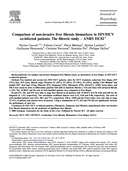Comparison of non-invasive liver fibrosis biomarkers in HIV/HCV co-infected patients: the fibrovic study--ANRS HC02.
Journal of hepatology
Cacoub P, Carrat F, Bedossa P, Lambert J, Penaranda G, Perronne C, Pol S, Halfon P
2008 J. Hepatol. Volume 48 Issue 5
PubMed 18314219 DOI 10.1016/j.jhep.2008.01.025
BACKGROUND/AIMS
To compare non-invasive biological liver fibrosis scores, as alternatives to liver biopsy, in HIV/HCV co-infected patients.
METHODS
Two hundred and seventy-two HIV/HCV patients, nai ve for HCV treatment, underwent liver biopsy [197 (72%) men, 39.9 years, fibrosis stage (Metavir) F1 (25%), F2 (40%), F3 (25%), F4 (10%), median CD4 486/mm(3) and median HIV viral load 3.5log. Fibrotest (FT), Hepascore (HS), Fibrometer (FM), SHASTA, APRI, Forns index, and Fib-4 were tested in order to differentiate patients with mild to moderate fibrosis (F2) and those with advanced fibrosis (F3). The AUROC and the rate of well-classified patients were compared to liver biopsy.
RESULTS
FT, HS, and FM were able to stage liver fibrosis in all patients with AUROCs of 0.78, 0.84 and 0.89 for the diagnosis of F2, respectively. The correlation coefficient indexes were 0.37, 0.46 and 0.48, respectively. The rates of well-classified patients were 62%, 68% and 71%, respectively. Fib-4, APRI and the Forn's index were only able to stage 37-61% of patients and showed lower accuracies. Using a combination of FT, HS and FM did not significantly increase the performance of each test.
CONCLUSIONS
In HIV/HCV co-infected patients, Fibrometer, Hepascore and Fibrotest outperformed other non-invasive liver fibrosis biomarkers for the prediction of significant liver fibrosis.
Citation Reference:

